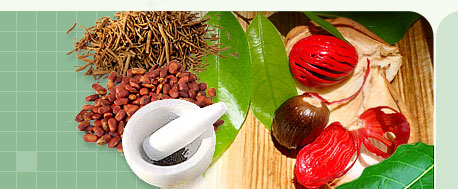 |
 |
Ayurveda PanchakarmaPanchakarama is the sacred manthra of rejuvenation. Panchakarma in Ayurveda means five types of therapeutic ways of treatment to eliminate toxins from the body and to replenish the tissues of the patient. Panchkarma constitutes the foremost Shodhana Chikitsa. Panchakarma is an Ayurvedic rejuvenator treatment, since it not only eliminates the toxins causing diseases, but also replenishes the tissue with nourishment; and therefore it is termed as a rejuvenating therapy. Shodhana therapy- This therapy is used to eliminate the cause of the disease. "Shodhana" means to "throw away" the toxins that are responsible for the diseases, instead of suppressing them. By eliminating the toxins, it restores balance to the biological humors of the body. The name Panchkarma is derived from two Sanskrit words, viz. "Panch" meaning "five" and "Karma" meaning "Action". The name denotes five primary procedures of cleansing, which Ayurveda uses to purify the body of everything abnormal. According to Charak School of thought it is termed as the five-purifactory procedures. Panchakarma or the shodhana therapy is always performed in three stages - Purva Karma (pre-treatment), Pradhana Karma (primary treatment), and Paschat Karma (post treatment). Purva karmaThere are two preparatory procedures before the actual procedures. These therapies are used to dislodge the toxins from the inner side of the human body and help them eliminate by the actual purifactory procedures. These are: 1) Snehanam (Oleation) - This therapy employs administration of medicated oils either internally or externally. 2) Swedanam (Fomentation) - The second major form of the preparatory procedures is termed as Swedanam. This therapy dilates the body's channels so that the aim of eliminating toxins would be facilitated. In addition to this it reduces the body's stiffness. Pradhan karmaAfter the aama (toxins) comes in to the kostha, it is eliminated by Panchkarma, i.e. vamana, virechana, basti, nasya, etc. This procedure is termed as Pradhankarma.
Paschat karmaDiet regimens, restricted bodily exertion and the intake of health promoting drugs, etc. come under the Paschatkarma (post treatment) therapy. Kerala PanchakarmaABHAYANGAMIt means oil massage. Medicated oil, according to the needs of the individual is massaged all over the body. The person undergoing Abhayangam reclines in different positions and usually the same lasts between 45 to 60 minutes. The recipient is made to lie on a wooden bed called ‘Dhoni.’ This treatment has been found highly effective in reducing mental tension and in increasing the strength and functional efficiency of the body muscles. Other beneficial effects of Abhayangam include better body circulation, improving vigor and vitality, better and sound sleep and reduced nervous weakness. UDHHVARTHANAMIt means to raise or elevate. Fine medicated powder is applied over the whole body with upward strokes of massage, quite opposite of the usual Ayurvedic massages. Udhhvarthanam is well known for its capability to induce perspiration, reduce obesity, diminish body odor, and improve skin complexion, and also to provide better mobility to the body joints. NJAVARAKIZHIIt involves the fomentation of the body by applying linen bags filled with ‘Njavara’ rice cooked in milk and medicated decoction made primarily from ‘Kurumthotti’ all over the body. It is very important to maintain a constant temperature while applying the linen bags and the paste of medicine is removed after specific period of application with palm leaf scrappers. This treatment has been found effective in treating the degenerative changes in musculo-skeletal structure and has been found to enhance strength, vitality and complexion of body. Njavarakizhi also prevents the complications caused due to old age debility. PIZHICHILIn this treatment warm medicated oil is squeezed over the whole body of the patient using a piece of cloth that is dipped in medicated lukewarm oil. A rhythmic pattern is followed while applying the oil, which is followed by a gentle massage. This therapy is effective in treating all types of nervous degenerative diseases including all types of paralysis. A treatment that stimulates body and its functional systems, Pizhichil is performed by Masseurs positioned at both sides of the dhroni. SWEDANAMIt is another form of sudation therapy where herbal steam is applied evenly on the entire body to produce perspiration. The head region is excluded from the treatment by putting the patient into a specially made steam chamber for around 15 to 20 minutes. Swedanam can be effectively utilized in treating muscular stiffness and numbness, and has been found to enhance the body’s blood circulation. THAKARADHARAIt is a form of Dhara (pouring) where medicated buttermilk is continuously poured over the forehead and scalp in an oscillating pattern for a period of 45 to 60 minutes. It has been found effective in rejuvenating the brain cells, thereby improving memory. It is frequently used to cure sleeplessness, mental tension, all types of headaches, premature graying and hair falling. Thakaradhara has also been found to be very effective in treating skin diseases like psoriasis. TAILADHARAIt is another form of Dhara. Also known as Snehadahara, it uses medicated lukewarm oil that is poured all over the body. A variation of this treatment is known as Sirodhara, which is very popular, where a vessel with a hole in the bottom is used to pour oil continuously on the scalp and forehead for 45 to 60 minutes. This therapy is very effective in maintaining the equilibrium of body and mind. It has also been found to increase the memory, clear voice tone and to provide relief from all types of stress and strain.
|
|